Analysis of UK Corporate Governance and International Models
VerifiedAdded on 2023/06/10
|17
|5390
|301
Report
AI Summary
This report provides a comprehensive analysis of international corporate governance, with a specific focus on the United Kingdom's framework. It begins by outlining the UK's publically listed and large firms' corporate governance structures, evaluating their strengths and potential areas for improvement. The report then delves into international models of corporate governance, discussing potential reforms that could address climate change and ESG considerations, which are increasingly driving investment decisions. Furthermore, it examines the obstacles to achieving international corporate governance convergence and establishing a unified set of rules. The report covers key aspects such as the role of the UK Corporate Governance Code, the Companies Act 2006, and the influence of the Financial Conduct Authority (FCA). The report concludes by summarizing the key findings and providing insights into the future of corporate governance in a globalized and environmentally conscious world, highlighting the challenges and opportunities in aligning governance practices across different nations.
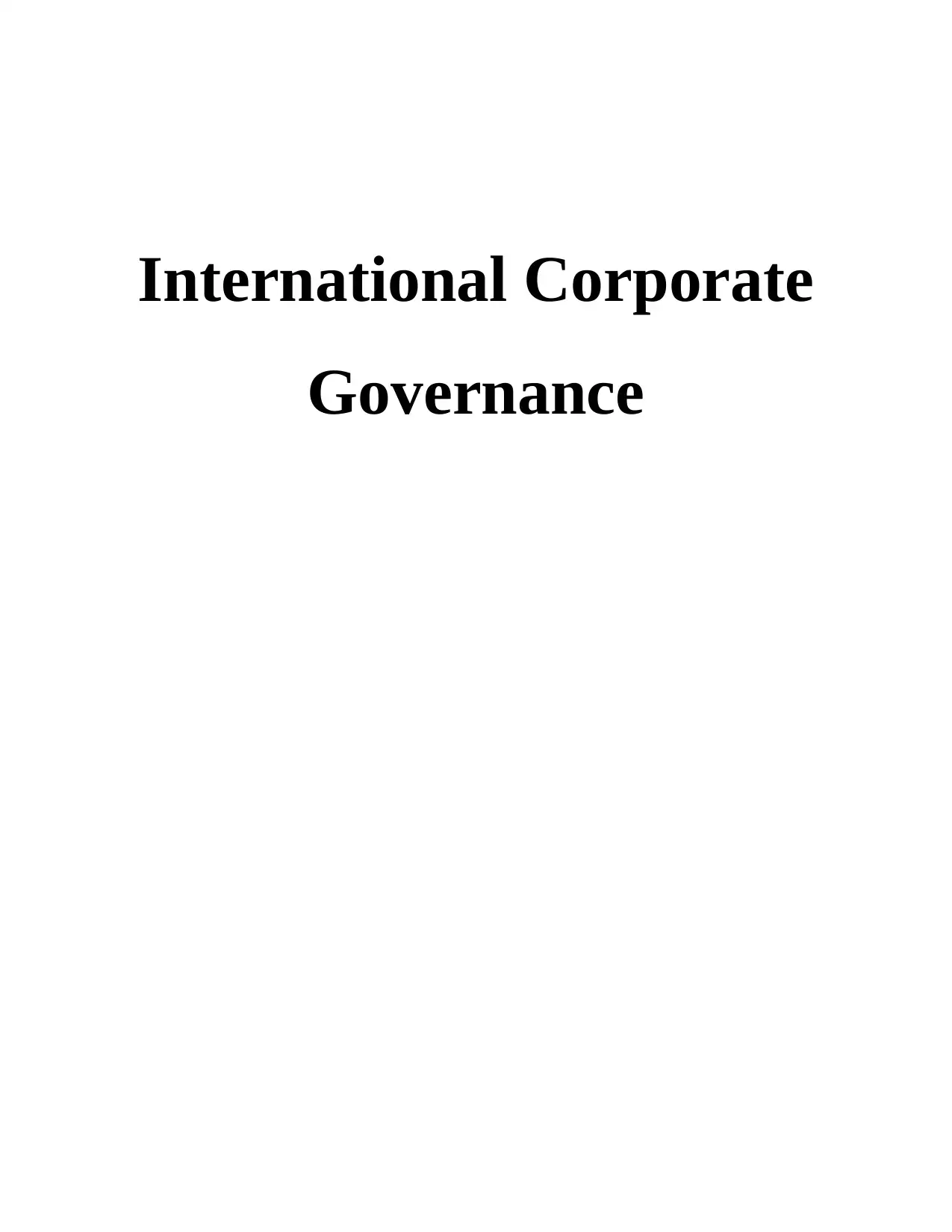
International Corporate
Governance
Governance
Paraphrase This Document
Need a fresh take? Get an instant paraphrase of this document with our AI Paraphraser

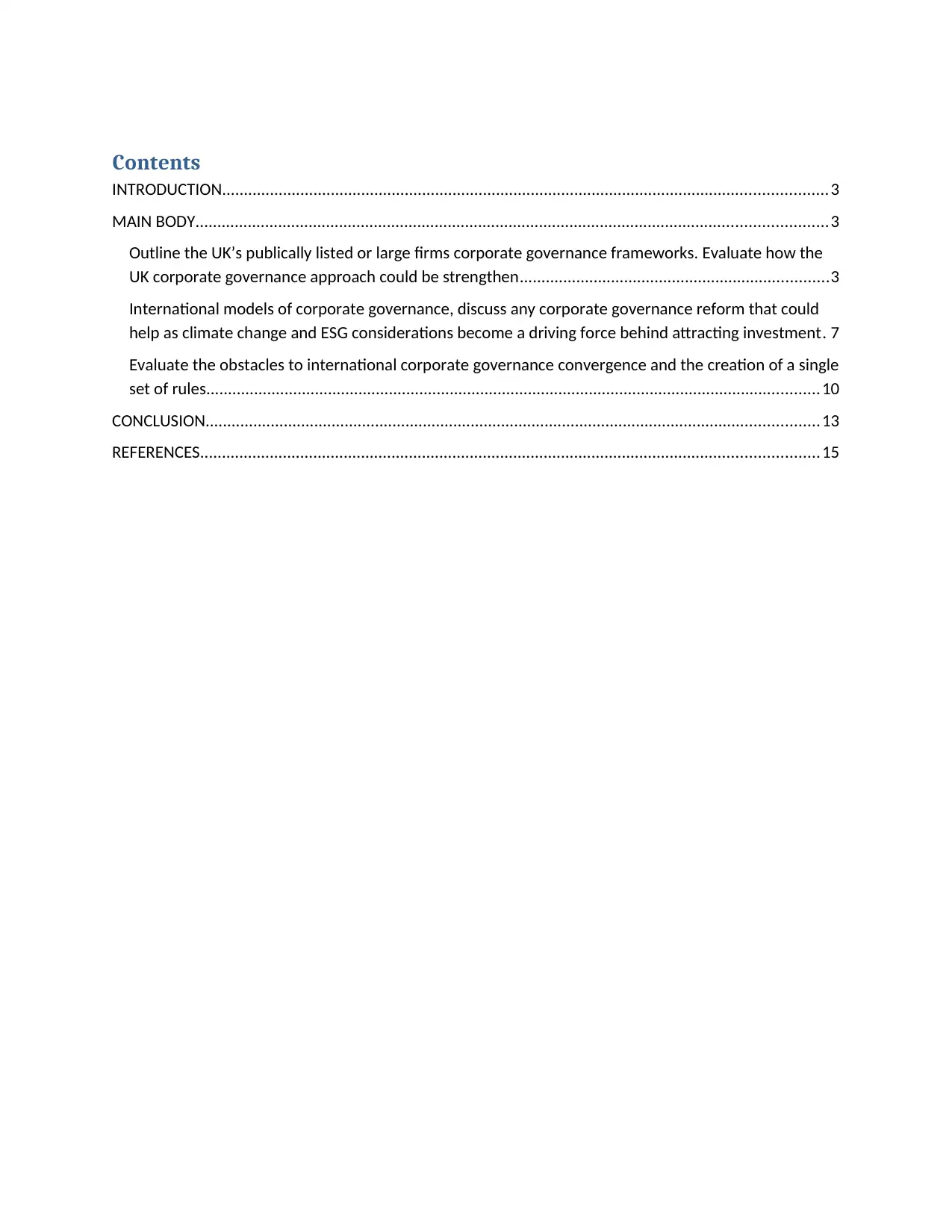
Contents
INTRODUCTION...........................................................................................................................................3
MAIN BODY.................................................................................................................................................3
Outline the UK’s publically listed or large firms corporate governance frameworks. Evaluate how the
UK corporate governance approach could be strengthen.......................................................................3
International models of corporate governance, discuss any corporate governance reform that could
help as climate change and ESG considerations become a driving force behind attracting investment. 7
Evaluate the obstacles to international corporate governance convergence and the creation of a single
set of rules.............................................................................................................................................10
CONCLUSION.............................................................................................................................................13
REFERENCES..............................................................................................................................................15
INTRODUCTION...........................................................................................................................................3
MAIN BODY.................................................................................................................................................3
Outline the UK’s publically listed or large firms corporate governance frameworks. Evaluate how the
UK corporate governance approach could be strengthen.......................................................................3
International models of corporate governance, discuss any corporate governance reform that could
help as climate change and ESG considerations become a driving force behind attracting investment. 7
Evaluate the obstacles to international corporate governance convergence and the creation of a single
set of rules.............................................................................................................................................10
CONCLUSION.............................................................................................................................................13
REFERENCES..............................................................................................................................................15
⊘ This is a preview!⊘
Do you want full access?
Subscribe today to unlock all pages.

Trusted by 1+ million students worldwide
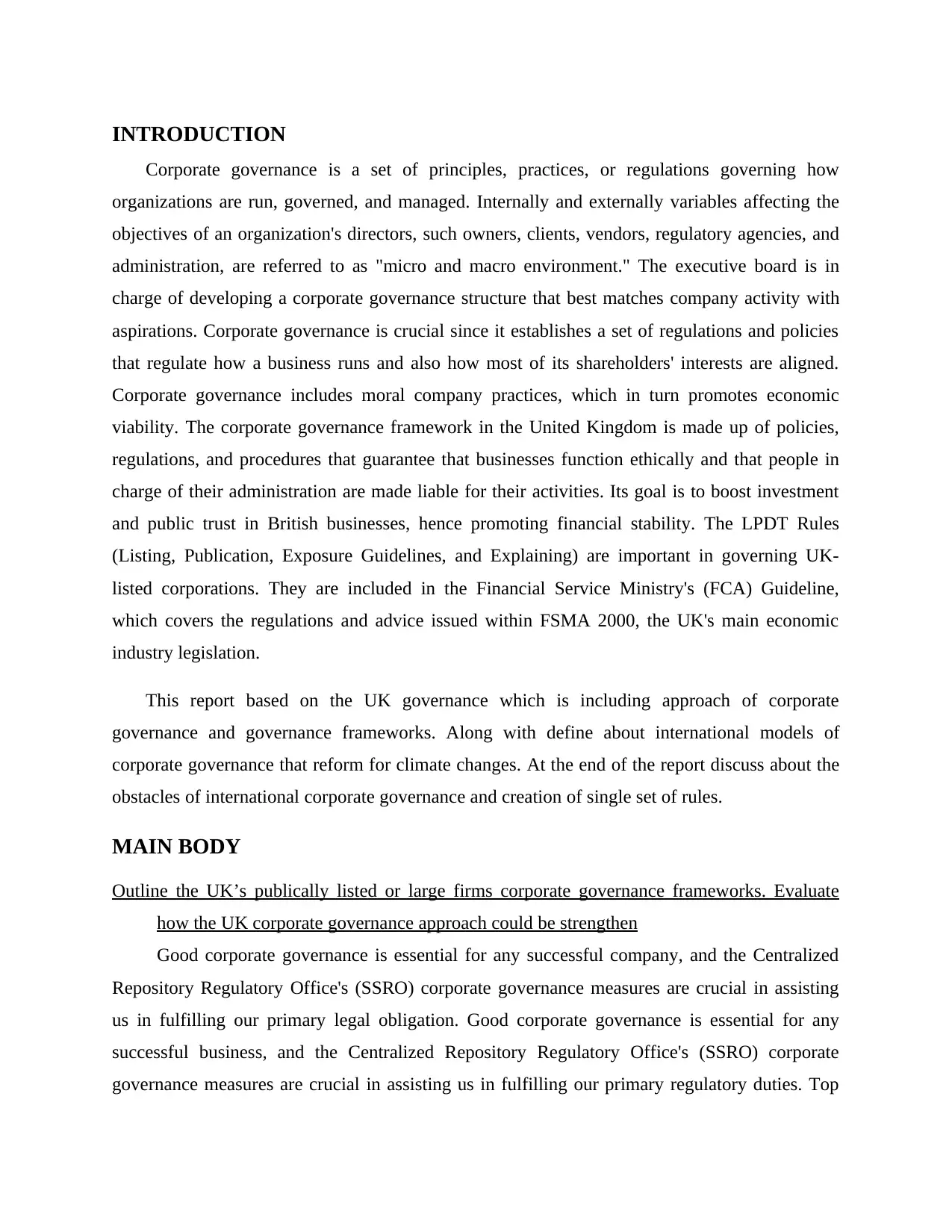
INTRODUCTION
Corporate governance is a set of principles, practices, or regulations governing how
organizations are run, governed, and managed. Internally and externally variables affecting the
objectives of an organization's directors, such owners, clients, vendors, regulatory agencies, and
administration, are referred to as "micro and macro environment." The executive board is in
charge of developing a corporate governance structure that best matches company activity with
aspirations. Corporate governance is crucial since it establishes a set of regulations and policies
that regulate how a business runs and also how most of its shareholders' interests are aligned.
Corporate governance includes moral company practices, which in turn promotes economic
viability. The corporate governance framework in the United Kingdom is made up of policies,
regulations, and procedures that guarantee that businesses function ethically and that people in
charge of their administration are made liable for their activities. Its goal is to boost investment
and public trust in British businesses, hence promoting financial stability. The LPDT Rules
(Listing, Publication, Exposure Guidelines, and Explaining) are important in governing UK-
listed corporations. They are included in the Financial Service Ministry's (FCA) Guideline,
which covers the regulations and advice issued within FSMA 2000, the UK's main economic
industry legislation.
This report based on the UK governance which is including approach of corporate
governance and governance frameworks. Along with define about international models of
corporate governance that reform for climate changes. At the end of the report discuss about the
obstacles of international corporate governance and creation of single set of rules.
MAIN BODY
Outline the UK’s publically listed or large firms corporate governance frameworks. Evaluate
how the UK corporate governance approach could be strengthen
Good corporate governance is essential for any successful company, and the Centralized
Repository Regulatory Office's (SSRO) corporate governance measures are crucial in assisting
us in fulfilling our primary legal obligation. Good corporate governance is essential for any
successful business, and the Centralized Repository Regulatory Office's (SSRO) corporate
governance measures are crucial in assisting us in fulfilling our primary regulatory duties. Top
Corporate governance is a set of principles, practices, or regulations governing how
organizations are run, governed, and managed. Internally and externally variables affecting the
objectives of an organization's directors, such owners, clients, vendors, regulatory agencies, and
administration, are referred to as "micro and macro environment." The executive board is in
charge of developing a corporate governance structure that best matches company activity with
aspirations. Corporate governance is crucial since it establishes a set of regulations and policies
that regulate how a business runs and also how most of its shareholders' interests are aligned.
Corporate governance includes moral company practices, which in turn promotes economic
viability. The corporate governance framework in the United Kingdom is made up of policies,
regulations, and procedures that guarantee that businesses function ethically and that people in
charge of their administration are made liable for their activities. Its goal is to boost investment
and public trust in British businesses, hence promoting financial stability. The LPDT Rules
(Listing, Publication, Exposure Guidelines, and Explaining) are important in governing UK-
listed corporations. They are included in the Financial Service Ministry's (FCA) Guideline,
which covers the regulations and advice issued within FSMA 2000, the UK's main economic
industry legislation.
This report based on the UK governance which is including approach of corporate
governance and governance frameworks. Along with define about international models of
corporate governance that reform for climate changes. At the end of the report discuss about the
obstacles of international corporate governance and creation of single set of rules.
MAIN BODY
Outline the UK’s publically listed or large firms corporate governance frameworks. Evaluate
how the UK corporate governance approach could be strengthen
Good corporate governance is essential for any successful company, and the Centralized
Repository Regulatory Office's (SSRO) corporate governance measures are crucial in assisting
us in fulfilling our primary legal obligation. Good corporate governance is essential for any
successful business, and the Centralized Repository Regulatory Office's (SSRO) corporate
governance measures are crucial in assisting us in fulfilling our primary regulatory duties. Top
Paraphrase This Document
Need a fresh take? Get an instant paraphrase of this document with our AI Paraphraser
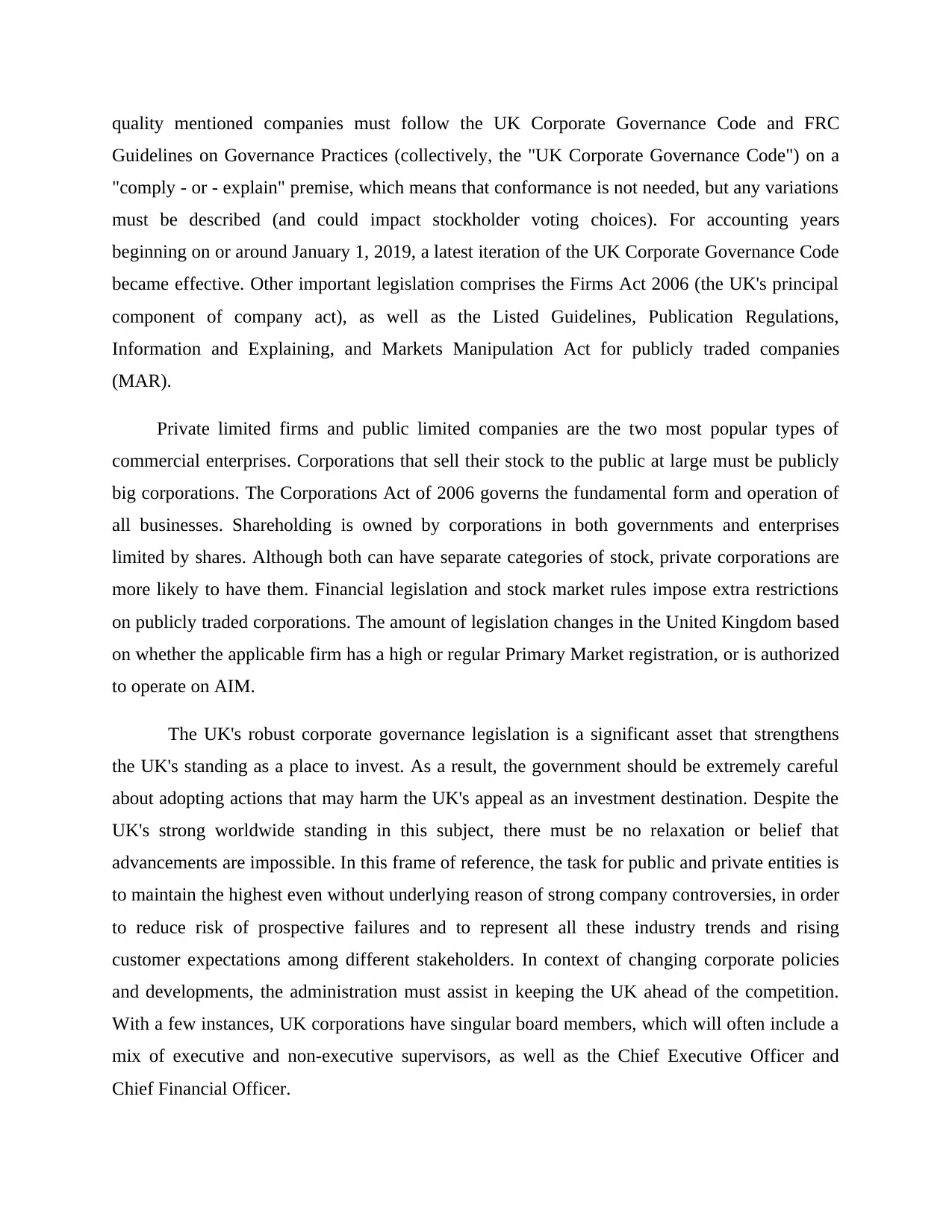
quality mentioned companies must follow the UK Corporate Governance Code and FRC
Guidelines on Governance Practices (collectively, the "UK Corporate Governance Code") on a
"comply - or - explain" premise, which means that conformance is not needed, but any variations
must be described (and could impact stockholder voting choices). For accounting years
beginning on or around January 1, 2019, a latest iteration of the UK Corporate Governance Code
became effective. Other important legislation comprises the Firms Act 2006 (the UK's principal
component of company act), as well as the Listed Guidelines, Publication Regulations,
Information and Explaining, and Markets Manipulation Act for publicly traded companies
(MAR).
Private limited firms and public limited companies are the two most popular types of
commercial enterprises. Corporations that sell their stock to the public at large must be publicly
big corporations. The Corporations Act of 2006 governs the fundamental form and operation of
all businesses. Shareholding is owned by corporations in both governments and enterprises
limited by shares. Although both can have separate categories of stock, private corporations are
more likely to have them. Financial legislation and stock market rules impose extra restrictions
on publicly traded corporations. The amount of legislation changes in the United Kingdom based
on whether the applicable firm has a high or regular Primary Market registration, or is authorized
to operate on AIM.
The UK's robust corporate governance legislation is a significant asset that strengthens
the UK's standing as a place to invest. As a result, the government should be extremely careful
about adopting actions that may harm the UK's appeal as an investment destination. Despite the
UK's strong worldwide standing in this subject, there must be no relaxation or belief that
advancements are impossible. In this frame of reference, the task for public and private entities is
to maintain the highest even without underlying reason of strong company controversies, in order
to reduce risk of prospective failures and to represent all these industry trends and rising
customer expectations among different stakeholders. In context of changing corporate policies
and developments, the administration must assist in keeping the UK ahead of the competition.
With a few instances, UK corporations have singular board members, which will often include a
mix of executive and non-executive supervisors, as well as the Chief Executive Officer and
Chief Financial Officer.
Guidelines on Governance Practices (collectively, the "UK Corporate Governance Code") on a
"comply - or - explain" premise, which means that conformance is not needed, but any variations
must be described (and could impact stockholder voting choices). For accounting years
beginning on or around January 1, 2019, a latest iteration of the UK Corporate Governance Code
became effective. Other important legislation comprises the Firms Act 2006 (the UK's principal
component of company act), as well as the Listed Guidelines, Publication Regulations,
Information and Explaining, and Markets Manipulation Act for publicly traded companies
(MAR).
Private limited firms and public limited companies are the two most popular types of
commercial enterprises. Corporations that sell their stock to the public at large must be publicly
big corporations. The Corporations Act of 2006 governs the fundamental form and operation of
all businesses. Shareholding is owned by corporations in both governments and enterprises
limited by shares. Although both can have separate categories of stock, private corporations are
more likely to have them. Financial legislation and stock market rules impose extra restrictions
on publicly traded corporations. The amount of legislation changes in the United Kingdom based
on whether the applicable firm has a high or regular Primary Market registration, or is authorized
to operate on AIM.
The UK's robust corporate governance legislation is a significant asset that strengthens
the UK's standing as a place to invest. As a result, the government should be extremely careful
about adopting actions that may harm the UK's appeal as an investment destination. Despite the
UK's strong worldwide standing in this subject, there must be no relaxation or belief that
advancements are impossible. In this frame of reference, the task for public and private entities is
to maintain the highest even without underlying reason of strong company controversies, in order
to reduce risk of prospective failures and to represent all these industry trends and rising
customer expectations among different stakeholders. In context of changing corporate policies
and developments, the administration must assist in keeping the UK ahead of the competition.
With a few instances, UK corporations have singular board members, which will often include a
mix of executive and non-executive supervisors, as well as the Chief Executive Officer and
Chief Financial Officer.
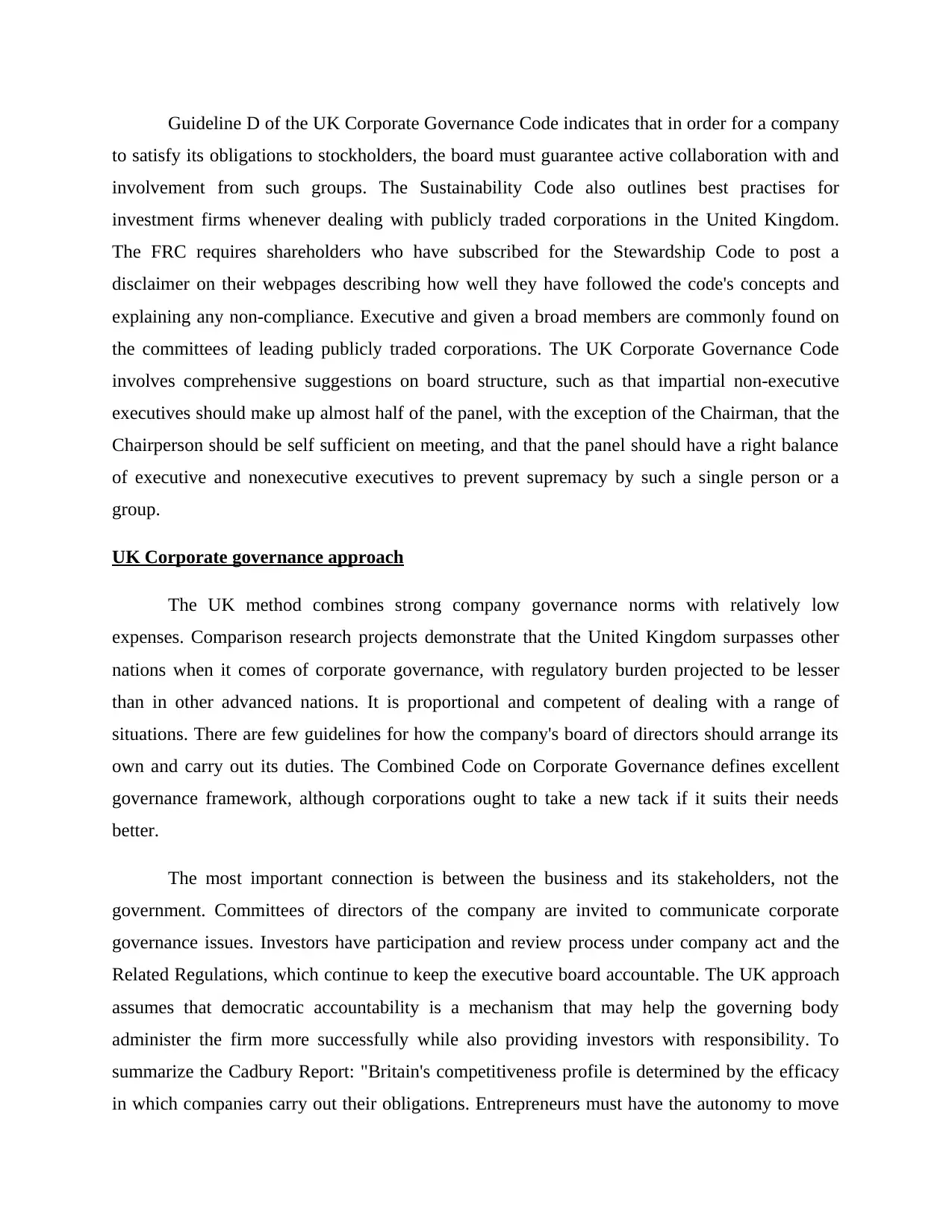
Guideline D of the UK Corporate Governance Code indicates that in order for a company
to satisfy its obligations to stockholders, the board must guarantee active collaboration with and
involvement from such groups. The Sustainability Code also outlines best practises for
investment firms whenever dealing with publicly traded corporations in the United Kingdom.
The FRC requires shareholders who have subscribed for the Stewardship Code to post a
disclaimer on their webpages describing how well they have followed the code's concepts and
explaining any non-compliance. Executive and given a broad members are commonly found on
the committees of leading publicly traded corporations. The UK Corporate Governance Code
involves comprehensive suggestions on board structure, such as that impartial non-executive
executives should make up almost half of the panel, with the exception of the Chairman, that the
Chairperson should be self sufficient on meeting, and that the panel should have a right balance
of executive and nonexecutive executives to prevent supremacy by such a single person or a
group.
UK Corporate governance approach
The UK method combines strong company governance norms with relatively low
expenses. Comparison research projects demonstrate that the United Kingdom surpasses other
nations when it comes of corporate governance, with regulatory burden projected to be lesser
than in other advanced nations. It is proportional and competent of dealing with a range of
situations. There are few guidelines for how the company's board of directors should arrange its
own and carry out its duties. The Combined Code on Corporate Governance defines excellent
governance framework, although corporations ought to take a new tack if it suits their needs
better.
The most important connection is between the business and its stakeholders, not the
government. Committees of directors of the company are invited to communicate corporate
governance issues. Investors have participation and review process under company act and the
Related Regulations, which continue to keep the executive board accountable. The UK approach
assumes that democratic accountability is a mechanism that may help the governing body
administer the firm more successfully while also providing investors with responsibility. To
summarize the Cadbury Report: "Britain's competitiveness profile is determined by the efficacy
in which companies carry out their obligations. Entrepreneurs must have the autonomy to move
to satisfy its obligations to stockholders, the board must guarantee active collaboration with and
involvement from such groups. The Sustainability Code also outlines best practises for
investment firms whenever dealing with publicly traded corporations in the United Kingdom.
The FRC requires shareholders who have subscribed for the Stewardship Code to post a
disclaimer on their webpages describing how well they have followed the code's concepts and
explaining any non-compliance. Executive and given a broad members are commonly found on
the committees of leading publicly traded corporations. The UK Corporate Governance Code
involves comprehensive suggestions on board structure, such as that impartial non-executive
executives should make up almost half of the panel, with the exception of the Chairman, that the
Chairperson should be self sufficient on meeting, and that the panel should have a right balance
of executive and nonexecutive executives to prevent supremacy by such a single person or a
group.
UK Corporate governance approach
The UK method combines strong company governance norms with relatively low
expenses. Comparison research projects demonstrate that the United Kingdom surpasses other
nations when it comes of corporate governance, with regulatory burden projected to be lesser
than in other advanced nations. It is proportional and competent of dealing with a range of
situations. There are few guidelines for how the company's board of directors should arrange its
own and carry out its duties. The Combined Code on Corporate Governance defines excellent
governance framework, although corporations ought to take a new tack if it suits their needs
better.
The most important connection is between the business and its stakeholders, not the
government. Committees of directors of the company are invited to communicate corporate
governance issues. Investors have participation and review process under company act and the
Related Regulations, which continue to keep the executive board accountable. The UK approach
assumes that democratic accountability is a mechanism that may help the governing body
administer the firm more successfully while also providing investors with responsibility. To
summarize the Cadbury Report: "Britain's competitiveness profile is determined by the efficacy
in which companies carry out their obligations. Entrepreneurs must have the autonomy to move
⊘ This is a preview!⊘
Do you want full access?
Subscribe today to unlock all pages.

Trusted by 1+ million students worldwide
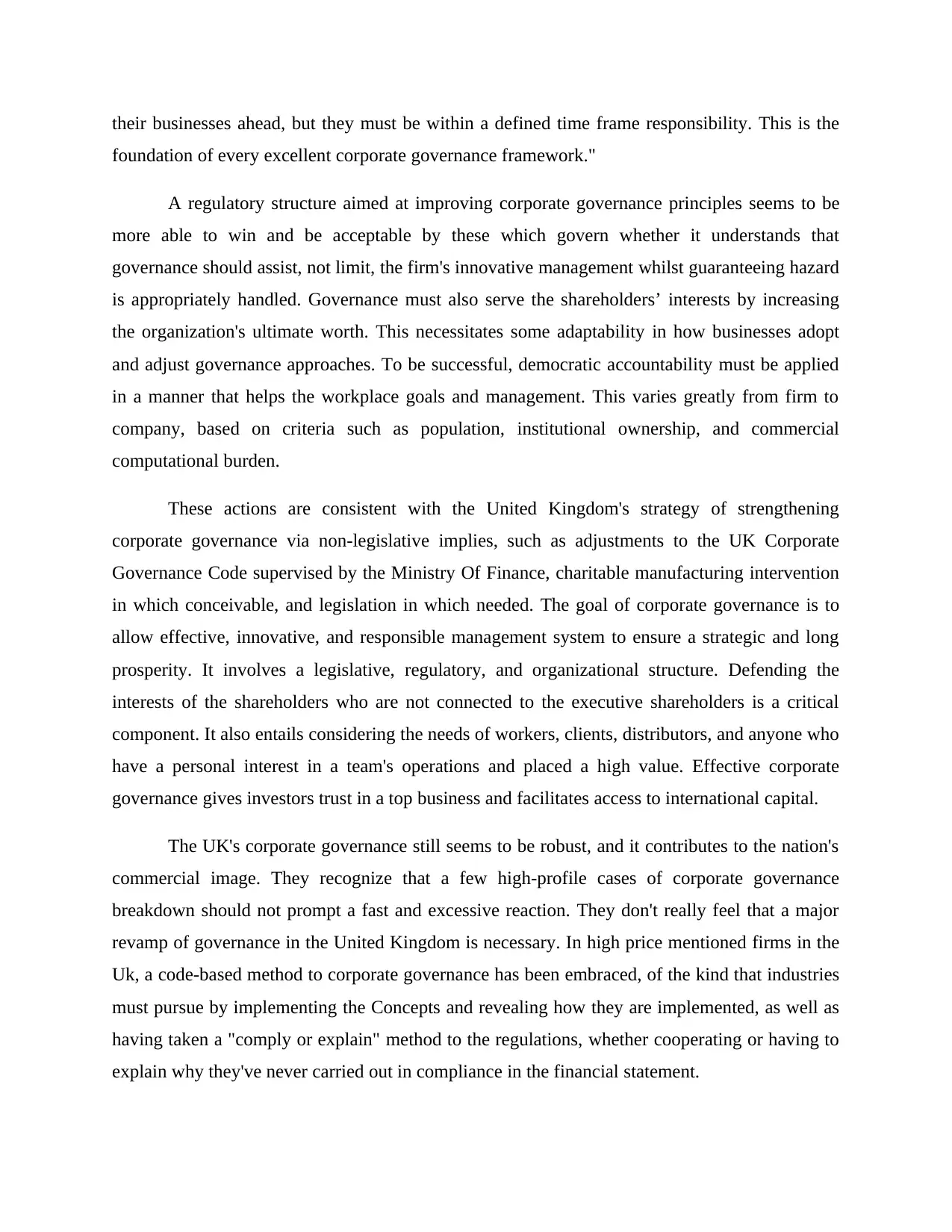
their businesses ahead, but they must be within a defined time frame responsibility. This is the
foundation of every excellent corporate governance framework."
A regulatory structure aimed at improving corporate governance principles seems to be
more able to win and be acceptable by these which govern whether it understands that
governance should assist, not limit, the firm's innovative management whilst guaranteeing hazard
is appropriately handled. Governance must also serve the shareholders’ interests by increasing
the organization's ultimate worth. This necessitates some adaptability in how businesses adopt
and adjust governance approaches. To be successful, democratic accountability must be applied
in a manner that helps the workplace goals and management. This varies greatly from firm to
company, based on criteria such as population, institutional ownership, and commercial
computational burden.
These actions are consistent with the United Kingdom's strategy of strengthening
corporate governance via non-legislative implies, such as adjustments to the UK Corporate
Governance Code supervised by the Ministry Of Finance, charitable manufacturing intervention
in which conceivable, and legislation in which needed. The goal of corporate governance is to
allow effective, innovative, and responsible management system to ensure a strategic and long
prosperity. It involves a legislative, regulatory, and organizational structure. Defending the
interests of the shareholders who are not connected to the executive shareholders is a critical
component. It also entails considering the needs of workers, clients, distributors, and anyone who
have a personal interest in a team's operations and placed a high value. Effective corporate
governance gives investors trust in a top business and facilitates access to international capital.
The UK's corporate governance still seems to be robust, and it contributes to the nation's
commercial image. They recognize that a few high-profile cases of corporate governance
breakdown should not prompt a fast and excessive reaction. They don't really feel that a major
revamp of governance in the United Kingdom is necessary. In high price mentioned firms in the
Uk, a code-based method to corporate governance has been embraced, of the kind that industries
must pursue by implementing the Concepts and revealing how they are implemented, as well as
having taken a "comply or explain" method to the regulations, whether cooperating or having to
explain why they've never carried out in compliance in the financial statement.
foundation of every excellent corporate governance framework."
A regulatory structure aimed at improving corporate governance principles seems to be
more able to win and be acceptable by these which govern whether it understands that
governance should assist, not limit, the firm's innovative management whilst guaranteeing hazard
is appropriately handled. Governance must also serve the shareholders’ interests by increasing
the organization's ultimate worth. This necessitates some adaptability in how businesses adopt
and adjust governance approaches. To be successful, democratic accountability must be applied
in a manner that helps the workplace goals and management. This varies greatly from firm to
company, based on criteria such as population, institutional ownership, and commercial
computational burden.
These actions are consistent with the United Kingdom's strategy of strengthening
corporate governance via non-legislative implies, such as adjustments to the UK Corporate
Governance Code supervised by the Ministry Of Finance, charitable manufacturing intervention
in which conceivable, and legislation in which needed. The goal of corporate governance is to
allow effective, innovative, and responsible management system to ensure a strategic and long
prosperity. It involves a legislative, regulatory, and organizational structure. Defending the
interests of the shareholders who are not connected to the executive shareholders is a critical
component. It also entails considering the needs of workers, clients, distributors, and anyone who
have a personal interest in a team's operations and placed a high value. Effective corporate
governance gives investors trust in a top business and facilitates access to international capital.
The UK's corporate governance still seems to be robust, and it contributes to the nation's
commercial image. They recognize that a few high-profile cases of corporate governance
breakdown should not prompt a fast and excessive reaction. They don't really feel that a major
revamp of governance in the United Kingdom is necessary. In high price mentioned firms in the
Uk, a code-based method to corporate governance has been embraced, of the kind that industries
must pursue by implementing the Concepts and revealing how they are implemented, as well as
having taken a "comply or explain" method to the regulations, whether cooperating or having to
explain why they've never carried out in compliance in the financial statement.
Paraphrase This Document
Need a fresh take? Get an instant paraphrase of this document with our AI Paraphraser
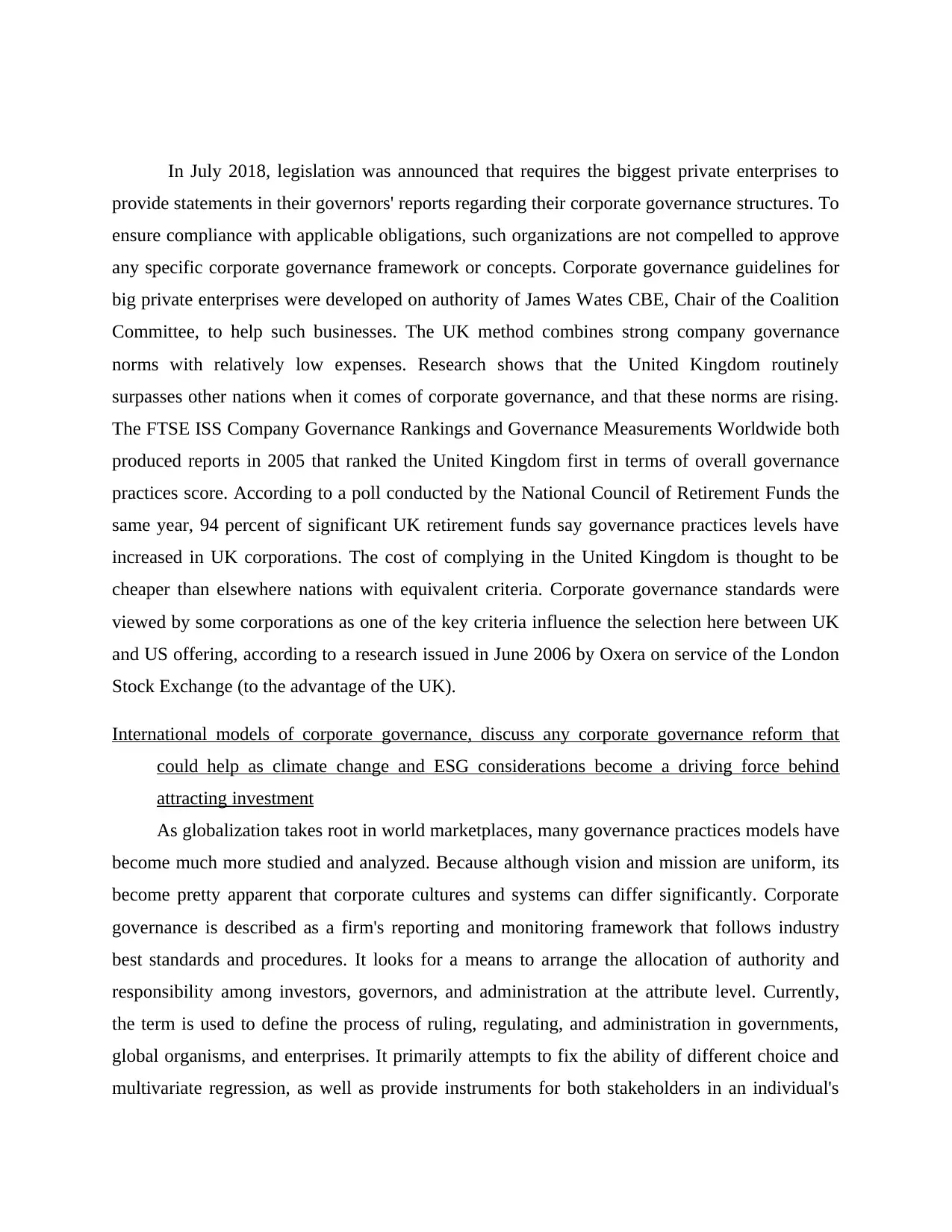
In July 2018, legislation was announced that requires the biggest private enterprises to
provide statements in their governors' reports regarding their corporate governance structures. To
ensure compliance with applicable obligations, such organizations are not compelled to approve
any specific corporate governance framework or concepts. Corporate governance guidelines for
big private enterprises were developed on authority of James Wates CBE, Chair of the Coalition
Committee, to help such businesses. The UK method combines strong company governance
norms with relatively low expenses. Research shows that the United Kingdom routinely
surpasses other nations when it comes of corporate governance, and that these norms are rising.
The FTSE ISS Company Governance Rankings and Governance Measurements Worldwide both
produced reports in 2005 that ranked the United Kingdom first in terms of overall governance
practices score. According to a poll conducted by the National Council of Retirement Funds the
same year, 94 percent of significant UK retirement funds say governance practices levels have
increased in UK corporations. The cost of complying in the United Kingdom is thought to be
cheaper than elsewhere nations with equivalent criteria. Corporate governance standards were
viewed by some corporations as one of the key criteria influence the selection here between UK
and US offering, according to a research issued in June 2006 by Oxera on service of the London
Stock Exchange (to the advantage of the UK).
International models of corporate governance, discuss any corporate governance reform that
could help as climate change and ESG considerations become a driving force behind
attracting investment
As globalization takes root in world marketplaces, many governance practices models have
become much more studied and analyzed. Because although vision and mission are uniform, its
become pretty apparent that corporate cultures and systems can differ significantly. Corporate
governance is described as a firm's reporting and monitoring framework that follows industry
best standards and procedures. It looks for a means to arrange the allocation of authority and
responsibility among investors, governors, and administration at the attribute level. Currently,
the term is used to define the process of ruling, regulating, and administration in governments,
global organisms, and enterprises. It primarily attempts to fix the ability of different choice and
multivariate regression, as well as provide instruments for both stakeholders in an individual's
provide statements in their governors' reports regarding their corporate governance structures. To
ensure compliance with applicable obligations, such organizations are not compelled to approve
any specific corporate governance framework or concepts. Corporate governance guidelines for
big private enterprises were developed on authority of James Wates CBE, Chair of the Coalition
Committee, to help such businesses. The UK method combines strong company governance
norms with relatively low expenses. Research shows that the United Kingdom routinely
surpasses other nations when it comes of corporate governance, and that these norms are rising.
The FTSE ISS Company Governance Rankings and Governance Measurements Worldwide both
produced reports in 2005 that ranked the United Kingdom first in terms of overall governance
practices score. According to a poll conducted by the National Council of Retirement Funds the
same year, 94 percent of significant UK retirement funds say governance practices levels have
increased in UK corporations. The cost of complying in the United Kingdom is thought to be
cheaper than elsewhere nations with equivalent criteria. Corporate governance standards were
viewed by some corporations as one of the key criteria influence the selection here between UK
and US offering, according to a research issued in June 2006 by Oxera on service of the London
Stock Exchange (to the advantage of the UK).
International models of corporate governance, discuss any corporate governance reform that
could help as climate change and ESG considerations become a driving force behind
attracting investment
As globalization takes root in world marketplaces, many governance practices models have
become much more studied and analyzed. Because although vision and mission are uniform, its
become pretty apparent that corporate cultures and systems can differ significantly. Corporate
governance is described as a firm's reporting and monitoring framework that follows industry
best standards and procedures. It looks for a means to arrange the allocation of authority and
responsibility among investors, governors, and administration at the attribute level. Currently,
the term is used to define the process of ruling, regulating, and administration in governments,
global organisms, and enterprises. It primarily attempts to fix the ability of different choice and
multivariate regression, as well as provide instruments for both stakeholders in an individual's
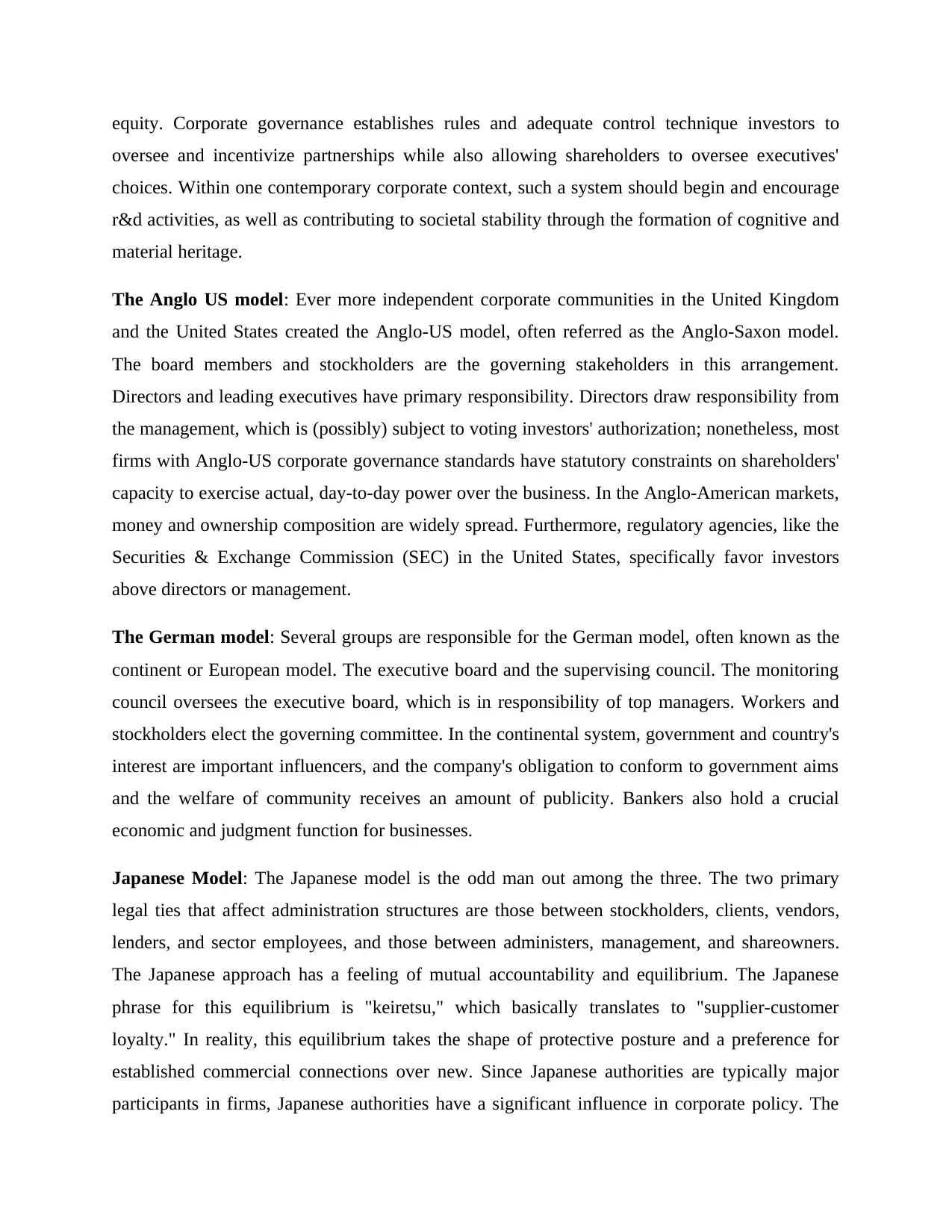
equity. Corporate governance establishes rules and adequate control technique investors to
oversee and incentivize partnerships while also allowing shareholders to oversee executives'
choices. Within one contemporary corporate context, such a system should begin and encourage
r&d activities, as well as contributing to societal stability through the formation of cognitive and
material heritage.
The Anglo US model: Ever more independent corporate communities in the United Kingdom
and the United States created the Anglo-US model, often referred as the Anglo-Saxon model.
The board members and stockholders are the governing stakeholders in this arrangement.
Directors and leading executives have primary responsibility. Directors draw responsibility from
the management, which is (possibly) subject to voting investors' authorization; nonetheless, most
firms with Anglo-US corporate governance standards have statutory constraints on shareholders'
capacity to exercise actual, day-to-day power over the business. In the Anglo-American markets,
money and ownership composition are widely spread. Furthermore, regulatory agencies, like the
Securities & Exchange Commission (SEC) in the United States, specifically favor investors
above directors or management.
The German model: Several groups are responsible for the German model, often known as the
continent or European model. The executive board and the supervising council. The monitoring
council oversees the executive board, which is in responsibility of top managers. Workers and
stockholders elect the governing committee. In the continental system, government and country's
interest are important influencers, and the company's obligation to conform to government aims
and the welfare of community receives an amount of publicity. Bankers also hold a crucial
economic and judgment function for businesses.
Japanese Model: The Japanese model is the odd man out among the three. The two primary
legal ties that affect administration structures are those between stockholders, clients, vendors,
lenders, and sector employees, and those between administers, management, and shareowners.
The Japanese approach has a feeling of mutual accountability and equilibrium. The Japanese
phrase for this equilibrium is "keiretsu," which basically translates to "supplier-customer
loyalty." In reality, this equilibrium takes the shape of protective posture and a preference for
established commercial connections over new. Since Japanese authorities are typically major
participants in firms, Japanese authorities have a significant influence in corporate policy. The
oversee and incentivize partnerships while also allowing shareholders to oversee executives'
choices. Within one contemporary corporate context, such a system should begin and encourage
r&d activities, as well as contributing to societal stability through the formation of cognitive and
material heritage.
The Anglo US model: Ever more independent corporate communities in the United Kingdom
and the United States created the Anglo-US model, often referred as the Anglo-Saxon model.
The board members and stockholders are the governing stakeholders in this arrangement.
Directors and leading executives have primary responsibility. Directors draw responsibility from
the management, which is (possibly) subject to voting investors' authorization; nonetheless, most
firms with Anglo-US corporate governance standards have statutory constraints on shareholders'
capacity to exercise actual, day-to-day power over the business. In the Anglo-American markets,
money and ownership composition are widely spread. Furthermore, regulatory agencies, like the
Securities & Exchange Commission (SEC) in the United States, specifically favor investors
above directors or management.
The German model: Several groups are responsible for the German model, often known as the
continent or European model. The executive board and the supervising council. The monitoring
council oversees the executive board, which is in responsibility of top managers. Workers and
stockholders elect the governing committee. In the continental system, government and country's
interest are important influencers, and the company's obligation to conform to government aims
and the welfare of community receives an amount of publicity. Bankers also hold a crucial
economic and judgment function for businesses.
Japanese Model: The Japanese model is the odd man out among the three. The two primary
legal ties that affect administration structures are those between stockholders, clients, vendors,
lenders, and sector employees, and those between administers, management, and shareowners.
The Japanese approach has a feeling of mutual accountability and equilibrium. The Japanese
phrase for this equilibrium is "keiretsu," which basically translates to "supplier-customer
loyalty." In reality, this equilibrium takes the shape of protective posture and a preference for
established commercial connections over new. Since Japanese authorities are typically major
participants in firms, Japanese authorities have a significant influence in corporate policy. The
⊘ This is a preview!⊘
Do you want full access?
Subscribe today to unlock all pages.

Trusted by 1+ million students worldwide
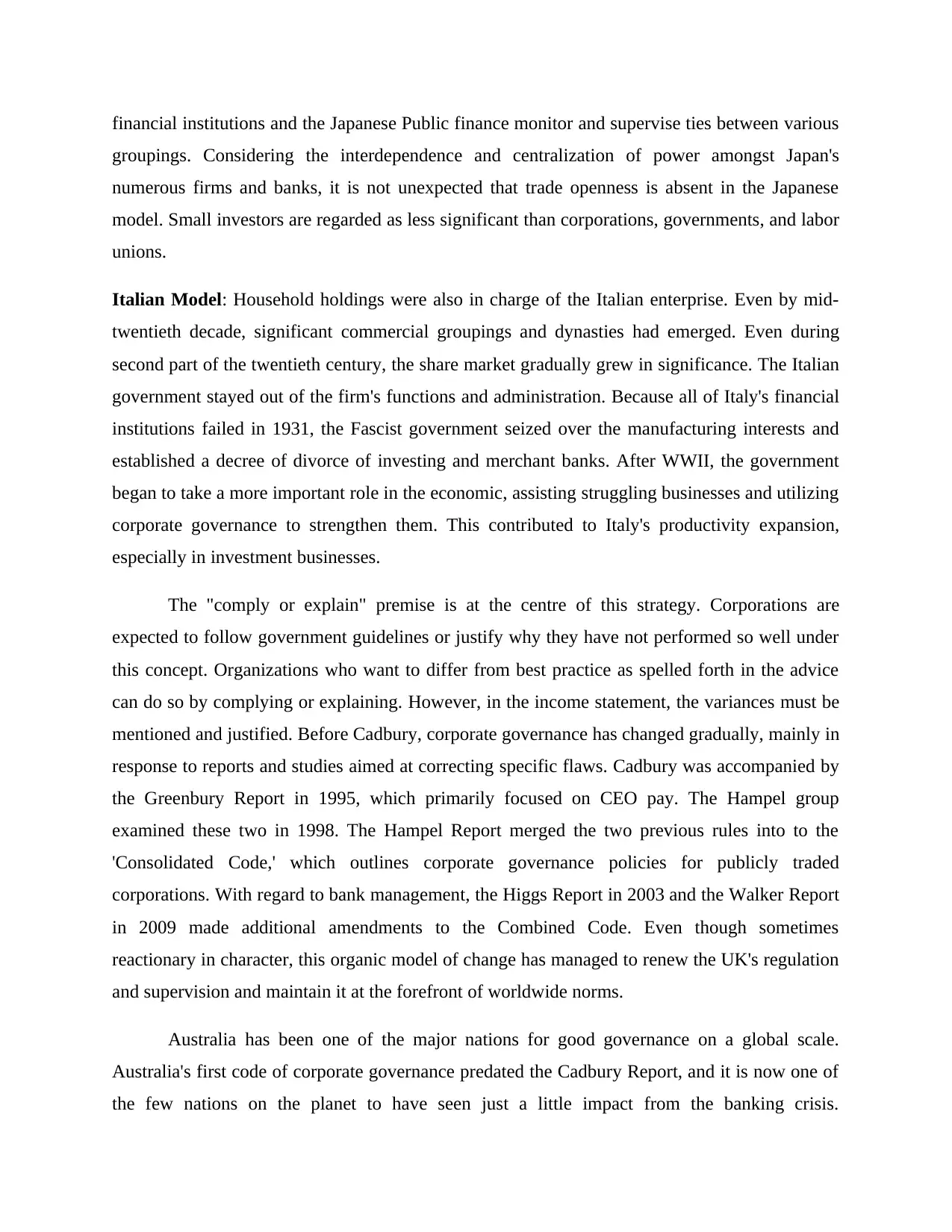
financial institutions and the Japanese Public finance monitor and supervise ties between various
groupings. Considering the interdependence and centralization of power amongst Japan's
numerous firms and banks, it is not unexpected that trade openness is absent in the Japanese
model. Small investors are regarded as less significant than corporations, governments, and labor
unions.
Italian Model: Household holdings were also in charge of the Italian enterprise. Even by mid-
twentieth decade, significant commercial groupings and dynasties had emerged. Even during
second part of the twentieth century, the share market gradually grew in significance. The Italian
government stayed out of the firm's functions and administration. Because all of Italy's financial
institutions failed in 1931, the Fascist government seized over the manufacturing interests and
established a decree of divorce of investing and merchant banks. After WWII, the government
began to take a more important role in the economic, assisting struggling businesses and utilizing
corporate governance to strengthen them. This contributed to Italy's productivity expansion,
especially in investment businesses.
The "comply or explain" premise is at the centre of this strategy. Corporations are
expected to follow government guidelines or justify why they have not performed so well under
this concept. Organizations who want to differ from best practice as spelled forth in the advice
can do so by complying or explaining. However, in the income statement, the variances must be
mentioned and justified. Before Cadbury, corporate governance has changed gradually, mainly in
response to reports and studies aimed at correcting specific flaws. Cadbury was accompanied by
the Greenbury Report in 1995, which primarily focused on CEO pay. The Hampel group
examined these two in 1998. The Hampel Report merged the two previous rules into to the
'Consolidated Code,' which outlines corporate governance policies for publicly traded
corporations. With regard to bank management, the Higgs Report in 2003 and the Walker Report
in 2009 made additional amendments to the Combined Code. Even though sometimes
reactionary in character, this organic model of change has managed to renew the UK's regulation
and supervision and maintain it at the forefront of worldwide norms.
Australia has been one of the major nations for good governance on a global scale.
Australia's first code of corporate governance predated the Cadbury Report, and it is now one of
the few nations on the planet to have seen just a little impact from the banking crisis.
groupings. Considering the interdependence and centralization of power amongst Japan's
numerous firms and banks, it is not unexpected that trade openness is absent in the Japanese
model. Small investors are regarded as less significant than corporations, governments, and labor
unions.
Italian Model: Household holdings were also in charge of the Italian enterprise. Even by mid-
twentieth decade, significant commercial groupings and dynasties had emerged. Even during
second part of the twentieth century, the share market gradually grew in significance. The Italian
government stayed out of the firm's functions and administration. Because all of Italy's financial
institutions failed in 1931, the Fascist government seized over the manufacturing interests and
established a decree of divorce of investing and merchant banks. After WWII, the government
began to take a more important role in the economic, assisting struggling businesses and utilizing
corporate governance to strengthen them. This contributed to Italy's productivity expansion,
especially in investment businesses.
The "comply or explain" premise is at the centre of this strategy. Corporations are
expected to follow government guidelines or justify why they have not performed so well under
this concept. Organizations who want to differ from best practice as spelled forth in the advice
can do so by complying or explaining. However, in the income statement, the variances must be
mentioned and justified. Before Cadbury, corporate governance has changed gradually, mainly in
response to reports and studies aimed at correcting specific flaws. Cadbury was accompanied by
the Greenbury Report in 1995, which primarily focused on CEO pay. The Hampel group
examined these two in 1998. The Hampel Report merged the two previous rules into to the
'Consolidated Code,' which outlines corporate governance policies for publicly traded
corporations. With regard to bank management, the Higgs Report in 2003 and the Walker Report
in 2009 made additional amendments to the Combined Code. Even though sometimes
reactionary in character, this organic model of change has managed to renew the UK's regulation
and supervision and maintain it at the forefront of worldwide norms.
Australia has been one of the major nations for good governance on a global scale.
Australia's first code of corporate governance predated the Cadbury Report, and it is now one of
the few nations on the planet to have seen just a little impact from the banking crisis.
Paraphrase This Document
Need a fresh take? Get an instant paraphrase of this document with our AI Paraphraser
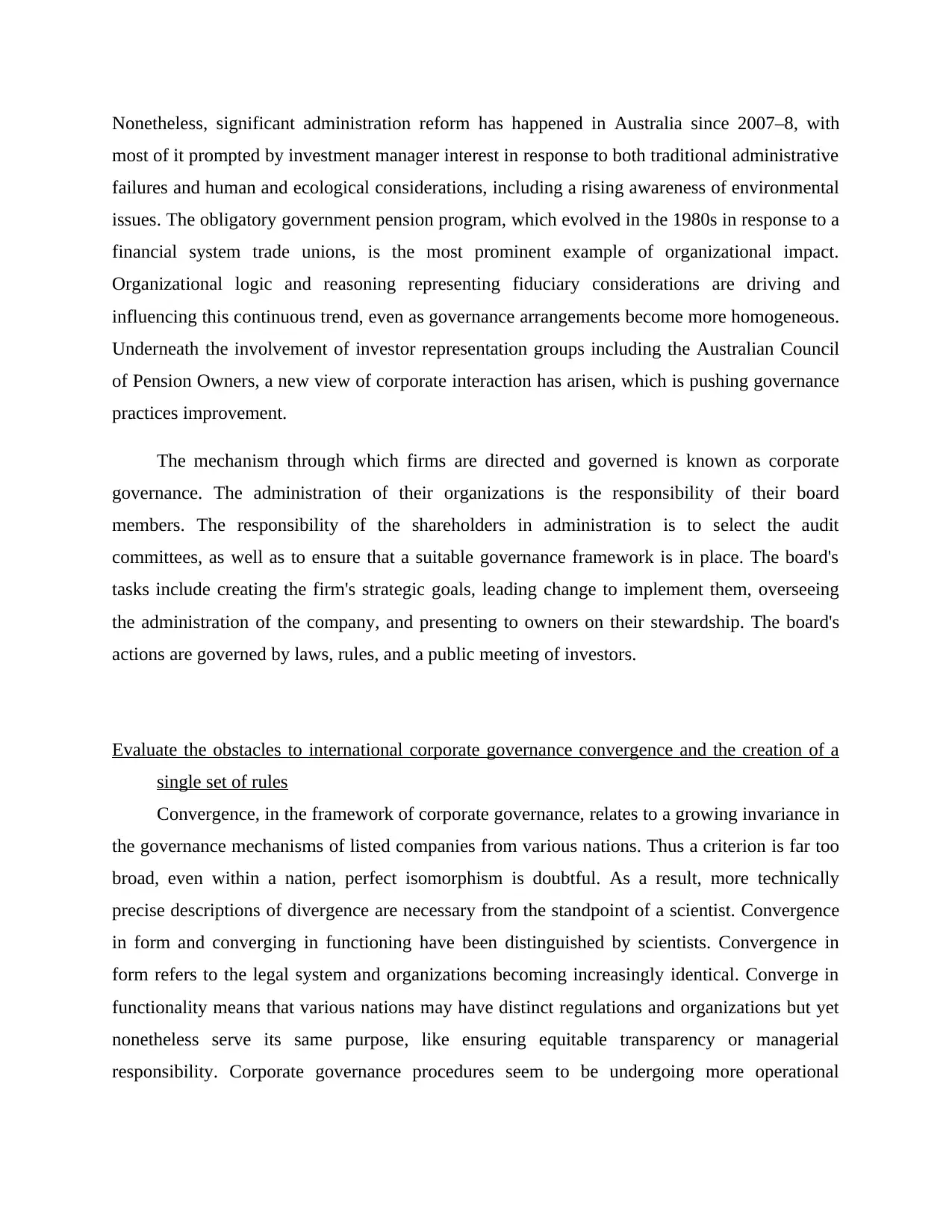
Nonetheless, significant administration reform has happened in Australia since 2007–8, with
most of it prompted by investment manager interest in response to both traditional administrative
failures and human and ecological considerations, including a rising awareness of environmental
issues. The obligatory government pension program, which evolved in the 1980s in response to a
financial system trade unions, is the most prominent example of organizational impact.
Organizational logic and reasoning representing fiduciary considerations are driving and
influencing this continuous trend, even as governance arrangements become more homogeneous.
Underneath the involvement of investor representation groups including the Australian Council
of Pension Owners, a new view of corporate interaction has arisen, which is pushing governance
practices improvement.
The mechanism through which firms are directed and governed is known as corporate
governance. The administration of their organizations is the responsibility of their board
members. The responsibility of the shareholders in administration is to select the audit
committees, as well as to ensure that a suitable governance framework is in place. The board's
tasks include creating the firm's strategic goals, leading change to implement them, overseeing
the administration of the company, and presenting to owners on their stewardship. The board's
actions are governed by laws, rules, and a public meeting of investors.
Evaluate the obstacles to international corporate governance convergence and the creation of a
single set of rules
Convergence, in the framework of corporate governance, relates to a growing invariance in
the governance mechanisms of listed companies from various nations. Thus a criterion is far too
broad, even within a nation, perfect isomorphism is doubtful. As a result, more technically
precise descriptions of divergence are necessary from the standpoint of a scientist. Convergence
in form and converging in functioning have been distinguished by scientists. Convergence in
form refers to the legal system and organizations becoming increasingly identical. Converge in
functionality means that various nations may have distinct regulations and organizations but yet
nonetheless serve its same purpose, like ensuring equitable transparency or managerial
responsibility. Corporate governance procedures seem to be undergoing more operational
most of it prompted by investment manager interest in response to both traditional administrative
failures and human and ecological considerations, including a rising awareness of environmental
issues. The obligatory government pension program, which evolved in the 1980s in response to a
financial system trade unions, is the most prominent example of organizational impact.
Organizational logic and reasoning representing fiduciary considerations are driving and
influencing this continuous trend, even as governance arrangements become more homogeneous.
Underneath the involvement of investor representation groups including the Australian Council
of Pension Owners, a new view of corporate interaction has arisen, which is pushing governance
practices improvement.
The mechanism through which firms are directed and governed is known as corporate
governance. The administration of their organizations is the responsibility of their board
members. The responsibility of the shareholders in administration is to select the audit
committees, as well as to ensure that a suitable governance framework is in place. The board's
tasks include creating the firm's strategic goals, leading change to implement them, overseeing
the administration of the company, and presenting to owners on their stewardship. The board's
actions are governed by laws, rules, and a public meeting of investors.
Evaluate the obstacles to international corporate governance convergence and the creation of a
single set of rules
Convergence, in the framework of corporate governance, relates to a growing invariance in
the governance mechanisms of listed companies from various nations. Thus a criterion is far too
broad, even within a nation, perfect isomorphism is doubtful. As a result, more technically
precise descriptions of divergence are necessary from the standpoint of a scientist. Convergence
in form and converging in functioning have been distinguished by scientists. Convergence in
form refers to the legal system and organizations becoming increasingly identical. Converge in
functionality means that various nations may have distinct regulations and organizations but yet
nonetheless serve its same purpose, like ensuring equitable transparency or managerial
responsibility. Corporate governance procedures seem to be undergoing more operational
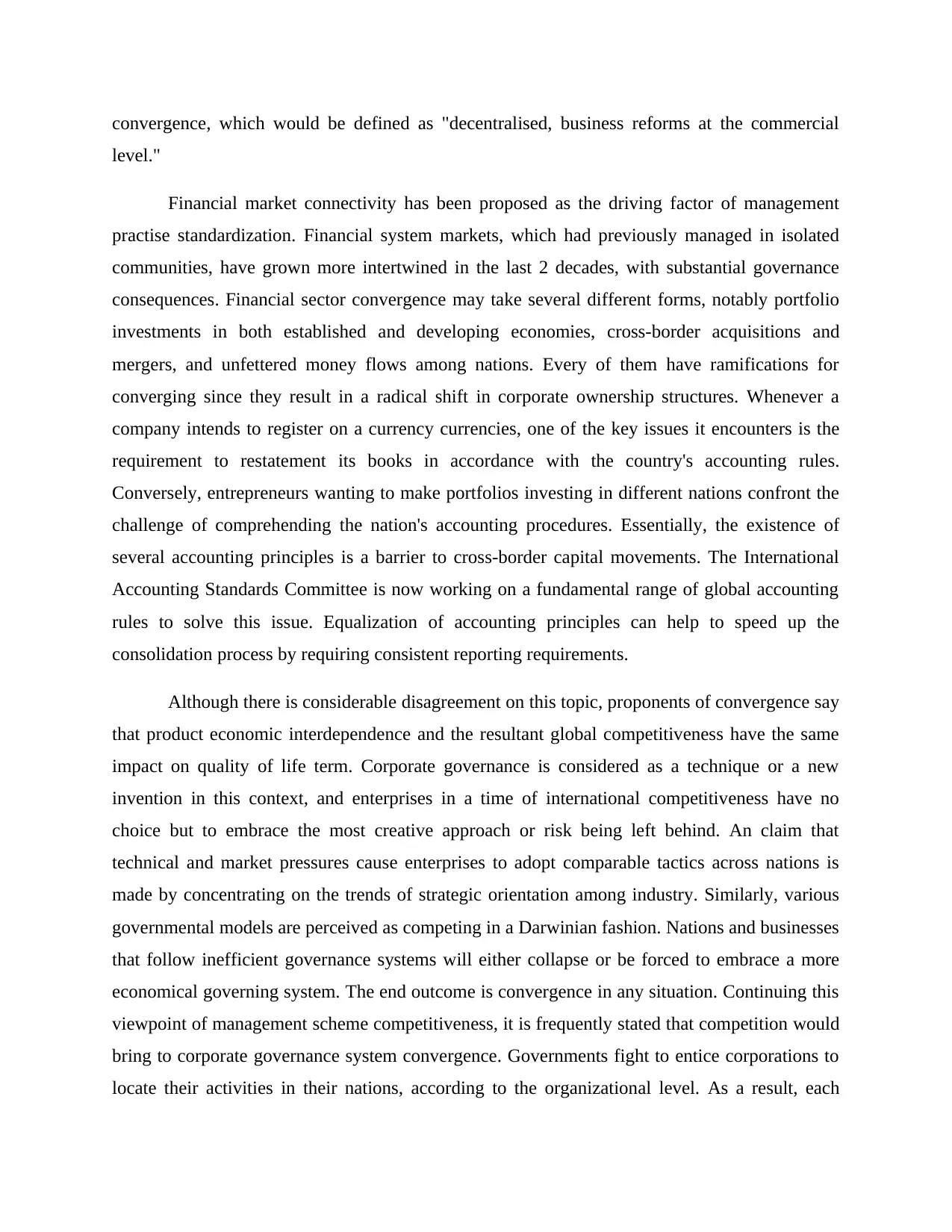
convergence, which would be defined as "decentralised, business reforms at the commercial
level."
Financial market connectivity has been proposed as the driving factor of management
practise standardization. Financial system markets, which had previously managed in isolated
communities, have grown more intertwined in the last 2 decades, with substantial governance
consequences. Financial sector convergence may take several different forms, notably portfolio
investments in both established and developing economies, cross-border acquisitions and
mergers, and unfettered money flows among nations. Every of them have ramifications for
converging since they result in a radical shift in corporate ownership structures. Whenever a
company intends to register on a currency currencies, one of the key issues it encounters is the
requirement to restatement its books in accordance with the country's accounting rules.
Conversely, entrepreneurs wanting to make portfolios investing in different nations confront the
challenge of comprehending the nation's accounting procedures. Essentially, the existence of
several accounting principles is a barrier to cross-border capital movements. The International
Accounting Standards Committee is now working on a fundamental range of global accounting
rules to solve this issue. Equalization of accounting principles can help to speed up the
consolidation process by requiring consistent reporting requirements.
Although there is considerable disagreement on this topic, proponents of convergence say
that product economic interdependence and the resultant global competitiveness have the same
impact on quality of life term. Corporate governance is considered as a technique or a new
invention in this context, and enterprises in a time of international competitiveness have no
choice but to embrace the most creative approach or risk being left behind. An claim that
technical and market pressures cause enterprises to adopt comparable tactics across nations is
made by concentrating on the trends of strategic orientation among industry. Similarly, various
governmental models are perceived as competing in a Darwinian fashion. Nations and businesses
that follow inefficient governance systems will either collapse or be forced to embrace a more
economical governing system. The end outcome is convergence in any situation. Continuing this
viewpoint of management scheme competitiveness, it is frequently stated that competition would
bring to corporate governance system convergence. Governments fight to entice corporations to
locate their activities in their nations, according to the organizational level. As a result, each
level."
Financial market connectivity has been proposed as the driving factor of management
practise standardization. Financial system markets, which had previously managed in isolated
communities, have grown more intertwined in the last 2 decades, with substantial governance
consequences. Financial sector convergence may take several different forms, notably portfolio
investments in both established and developing economies, cross-border acquisitions and
mergers, and unfettered money flows among nations. Every of them have ramifications for
converging since they result in a radical shift in corporate ownership structures. Whenever a
company intends to register on a currency currencies, one of the key issues it encounters is the
requirement to restatement its books in accordance with the country's accounting rules.
Conversely, entrepreneurs wanting to make portfolios investing in different nations confront the
challenge of comprehending the nation's accounting procedures. Essentially, the existence of
several accounting principles is a barrier to cross-border capital movements. The International
Accounting Standards Committee is now working on a fundamental range of global accounting
rules to solve this issue. Equalization of accounting principles can help to speed up the
consolidation process by requiring consistent reporting requirements.
Although there is considerable disagreement on this topic, proponents of convergence say
that product economic interdependence and the resultant global competitiveness have the same
impact on quality of life term. Corporate governance is considered as a technique or a new
invention in this context, and enterprises in a time of international competitiveness have no
choice but to embrace the most creative approach or risk being left behind. An claim that
technical and market pressures cause enterprises to adopt comparable tactics across nations is
made by concentrating on the trends of strategic orientation among industry. Similarly, various
governmental models are perceived as competing in a Darwinian fashion. Nations and businesses
that follow inefficient governance systems will either collapse or be forced to embrace a more
economical governing system. The end outcome is convergence in any situation. Continuing this
viewpoint of management scheme competitiveness, it is frequently stated that competition would
bring to corporate governance system convergence. Governments fight to entice corporations to
locate their activities in their nations, according to the organizational level. As a result, each
⊘ This is a preview!⊘
Do you want full access?
Subscribe today to unlock all pages.

Trusted by 1+ million students worldwide
1 out of 17
Related Documents
Your All-in-One AI-Powered Toolkit for Academic Success.
+13062052269
info@desklib.com
Available 24*7 on WhatsApp / Email
![[object Object]](/_next/static/media/star-bottom.7253800d.svg)
Unlock your academic potential
Copyright © 2020–2025 A2Z Services. All Rights Reserved. Developed and managed by ZUCOL.





